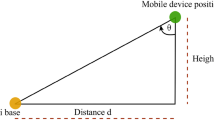Abstract
How should the World Wide Web look like if it were for location-based information? And how would mobile, spatially aware applications deal with such a platform? In this paper we present the neXus Augmented World Model, an object oriented data model which plays a major role in an open framework for both providers of location-based information and new kinds of applications: the neXus platform. We illustrate the usability of the model with several sample applications and show the extensibility of this framework. At last we present a stepwise approach for building spatially aware applications in this environment.
Similar content being viewed by others
References
Long S, Kooper R, Abowd GD, Atkeson CG (1996) Rapid Prototyping of Mobile Context-Aware Applications: The Cyberguide Case Study. In: Proceedings of the Second Annual International Conference on Mobile Computing and Networking (MobiCom ’96), pp 97–107, Rye, New York, USA, ACM Press
Malaka R, Zipf A (2000) Deep Map – Challenging IT Research in the Framework of a Tourist Information System. In: Fesenmaier DR, Klein S, Buhalis D (eds) Information and communication technologies in tourism 2000, pp 15–27, Springer-Verlag, Wien, New York
Leonhardi A, Kubach U, Rothermel K, Fritz A (1999) Virtual Information Towers – A Metaphor for Intuitive, Location-Aware Information Access in a Mobile Environment. In: Proceedings of the Third International Symposium on Wearable Computers (ISWC’99), San Fransisco, CA, USA, IEEE Press
Leonhardi A, Kubach U (1999) An Architecture for a Distributed Universal Location Service. In: Proceedings of the European Wireless ’99 Conference, Munich, Germany, ITG Fachbericht, VDE Verlag, pp 351–355
Chamberlin DD, Robie J, Florescu D (2000) Quilt: An XML Query Language for Heterogeneous Data Sources. WebDB (Informal Proceedings), pp 53–62
Open GIS Consortium (2000) Geography Markup Language (GML) v1.0. Recommendation paper, OGC Document Number: 00-029, Date: 12-May-2000. Avaible at http://www.opengis.org
Nicklas D, Grossmann M, Schwarz T, Volz S, Mitschang B (2001) A Model-Based, Open Architecture for Mobile, Spatially Aware Applications. In: Proceedings of Symposium on Spatial and Temporal Databases, Los Angeles
Hohl F, Kubach U, Leonhardi A, Rothermel K, Schwehm M (1999) Next Century Challenges: NeXus – An Open Global Infrastructure for Spatial-Aware Applications. In: Imielinski T, Steenstrup M (eds) Proceedings of the Fifth Annual ACM/IEEE International Conference on Mobile Computing and Networking (MobiCom’99). ACM Press, pp 249–255
Spohrer J (1999) WorldBoard; What Comes After the WWW? Learning Communities Group, ATG, (c) Apple Computer, Inc. Available at: http://worldboard.org/pub/spohrer/wbconcept/default.html, June 16
Boag S, Chamberlin D, Fernandez M, Florescu D, Robie J, Simeon J (eds) (2002) Query: A Query Language for XML, W3C Working Draft, August 16. http://www.w3.org/TR/2002/WD-xquery-20020816/
Author information
Authors and Affiliations
Corresponding author
Rights and permissions
About this article
Cite this article
Nicklas, D., Mitschang, B. On building location aware applications using an open platform based on the NEXUS Augmented World Model. Softw Syst Model 3, 303–313 (2004). https://doi.org/10.1007/s10270-004-0055-0
Received:
Accepted:
Published:
Issue Date:
DOI: https://doi.org/10.1007/s10270-004-0055-0




